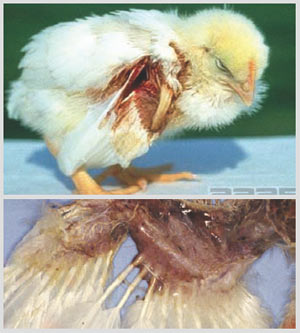
Collett: 'We've seen GD lesions develop from damage to intestinal mucosa'
 "In cattle and
sheep, we've seen GD lesions develop from damage to the intestinal mucosa, so we're starting to take a closer look at that in poultry."
"In cattle and
sheep, we've seen GD lesions develop from damage to the intestinal mucosa, so we're starting to take a closer look at that in poultry."
DR. STEPHEN COLLETT
In recent years, poultry growers have been seeing an increase in the incidence of gangrenous dermatitis (GD)—a subcutaneous infection in poultry that may be caused by clostridial bacteria of various species.
It's become a major health problem among
broiler flocks in the United States, resulting
in high mortality, carcass condemnations
and trimmed parts. Economic losses have
been estimated to be as much as $1.31 per
affected bird.
Poultry researchers are not yet sure why
gangrenous dermatitis is on the rise, but
they are making headway in understanding
this complex disease. One of the insights
they have gained recently points increasingly
to a possible link between GD and
intestinal health.
Dr. Stephen Collett, professor of veterinary
medicine at the University of Georgia,
delivered a presentation on gangrenous
dermatitis at the Orlando meeting and
highlighted what has been learned about
this intriguing disease.
GD requires portal of entry
Collett began his talk by explaining that
three primary etiologic agents are responsible
for breaks of gangrenous dermatitis:
Clostridium perfringens, Clostridium
septicum and Staphylococcus aureus.
None of these organisms, he said, is adept
at infecting its host without a portal of
entry. "They need a damaged area," Collett
added. "Often it's damaged skin, a scratch.
But in cattle and sheep, we've seen GD
lesions develop from damage to the intestinal
mucosa, so we're starting to take a
closer look at that in poultry."
Immune suppression also plays a key role
in setting up the host for infection.
Infectious bursal disease (IBD), chick
anemia virus (CAV) and other common
poultry problems all can take a heavy toll
on bird immunity and make conditions ripe
for a GD break.
Environmental stressors also come into
play. Extremes in temperature can, of
course, sap bird immunity. In addition, such
extremes—especially the combination
of high heat and moisture—can foster
conditions that make it easy for GD's
causative organisms to grow and thrive in
broiler houses. It is not surprising, then,
that GD has the tendency to be a recurring
problem on farms where favorable environmental
conditions exist, Collett said.

So-called ’blue wing’ lesions are common in
immunocompromised chicks that have been
vertically infected with chick anemia virus.
(Photos courtesy of Dr. Collett.)
GD has an incubation period of 3 to 5
weeks and the course of the disease is 10
days to 2 weeks. Collett emphasized that
one of the unfortunate characteristics of
GD is that it tends to be a late-stage illness,
with the disease often appearing in birds
after considerable resources have already
been spent growing them.
Few clinical signs of gangrenous dermatitis
are observed in the field. "We find dead
birds; we don't see many clinical signs,"
Collett said. "But one sign of GD you do see
in the field are blue-wing lesions. That
occurs especially in young chicks that have
been infected vertically with CAV. Their
immune systems are very compromised and
they develop those typical kinds of lesions."
Postmortem examinations of birds with
GD exhibit massive hemorrhaging under the
skin, along the back, the thigh and the hips.
GD-causing organisms characteristically
are gas forming, so an accumulation of gas
is often seen in the liver and sometimes in
other anatomic structures. Postmortem
studies may also show evidence of retained
yolk sacs (associated with poor chick quality),
anemia and pallor in the appearance of
bone marrow.
Control of GD demands multifaceted effort
Collett said that treatment and prevention
of GD is best coordinated on several fronts:
- Providing good nutrition
- Controlling moisture content in the
litter (with frequent clean-outs)
- Using vaccines to thwart
immunosuppressive diseases
such as IBD and CAV
- Reducing risks of skin injury
by limiting stocking density and
providing adequate feed and
water to reduce pecking
- Administering antibiotics
as needed
Interestingly, Collett said that experience
in human medicine is helping poultry
researchers better understand when to use
the various types of therapeutic antibiotics.
"For example, what they find in humans is
that penicillin is very effective at killing off
an organism, but it's very ineffective at
stopping an infection that has already
begun," he said, adding that researchers
think that may be because penicillin
appears to have no effect on the chain of
events that produce toxins in the organism.
"But if they instead treat an already infected
person with tetracycline instead of penicillin, there's a much greater
effect—not because tetracycline is
more effective at killing the organism,
but because it shuts off the genetic
pathway for producing toxin."
Collett says that with an eye on those
observations in human medicine, many
poultry veterinarians are now leaning
toward in-feed tetracycline as the drug
of choice for treating GD breaks.
Published reports have suggested that
coccidiosis vaccination may indirectly
help reduce or eliminate the incidence
of GD by greatly lowering the risk of
coccidiosis breaks resulting from late
coccidia cycling. (See CocciForum No. 12b)
Spring 2008
Back to North American Edition (#1)


 So-called ’blue wing’ lesions are common in
immunocompromised chicks that have been
vertically infected with chick anemia virus.
So-called ’blue wing’ lesions are common in
immunocompromised chicks that have been
vertically infected with chick anemia virus.







